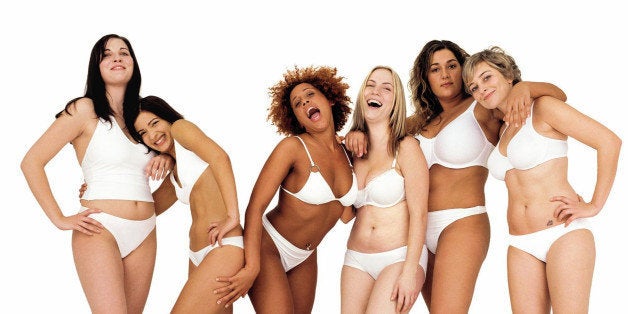
One of the biggest conceptual ad campaigns of the decade grew out of a photography exhibit in a retail building in Toronto.
"Beyond Compare: Women Photographers On Real Beauty," a show organized by Dove and Ogilvy & Mather, featured work from 67 female photographers including Annie Leibovitz, Tierney Gearon and Peggy Sirota. And it marked the beginning of Dove's quest to understand how women thought about beauty -- a conversation that would eventually become the Dove Campaign For Real Beauty.
Ten years after the exhibition opened, the Campaign For Real Beauty is one of modern marketing's most talked-about success stories. The campaign has expanded from billboards to television ads and online videos: The 2006 video, "Evolution," went viral before "viral" was even a thing. (After all, YouTube had only launched the year before.) And Dove's 2013 spot "Real Beauty Sketches," which shows women describing their appearances to a forensic sketch artist, became the most-watched video ad of all time.
How did a brand associated with a plain white bar of soap get men and women worldwide to think about the narrow definitions of female beauty? And does the fact that this message comes from a brand owned by Unilever -- the company behind the very sexily marketed Axe -- make it less authentic or important?
THE START OF SOMETHING
In the early 2000s, Dove executives began looking for a way to revive a brand that was being overshadowed by other companies. Their PR agency, Edelman, conducted a study of more than 3,000 women in 10 countries in order to learn about women's priorities and interests. When it reported that only 2 percent of the women interviewed considered themselves beautiful, the executives at Dove saw an opportunity. As they moved beyond the bar of soap and introduced other products such as shampoo and body wash, could they also start a conversation about beauty? Would a campaign that tapped into what women were thinking and feeling help Dove become more relevant -- and more profitable?
Dove's first steps in the Campaign For Real Beauty included "Tick Box" billboards, which debuted in Canada and spread across the United States and United Kingdom. The outdoor billboards featured images of women with two tick-box options next to them such as "fat or fit?" and "grey or gorgeous?"
Passersby could text their vote to a listed number, and the percentages appeared next to the image on the billboard. The campaign led 1.5 million visitors to the Campaign for Real Beauty website, alerting Dove that it was on the right track -- this was a topic women wanted to talk about.
AUTHENTICITY QUESTIONED
Dove's critics were quick to point out that the brand's owner, Unilever, was the parent company of Slimfast, Axe and Fair & Lovely skin-whitening cream. How could a message about "real beauty" coming from a corporation that sells diet products and advertises men's body spray with sexist tropes about women possibly be authentic?
According to Jean Kilbourne, creator of the "Killing Us Softly" documentary series which explores how women are portrayed in advertising, these objections are important -- but the anger toward Dove is misdirected.
"I think that's a good reason to go after Unilever, or to go after Axe," she told The Huffington Post. "But I actually don't think the people at Dove have much control over that."
A second criticism sometimes leveled at Dove is that its cosmetic products feed into women's insecurities.
"For the most part, I think that Dove's products are innocuous," Kilbourne told HuffPost. "It's soap and body wash. I do have an issue with products like cellulite-firming cream [which Dove sells] -- it's just one more way to create anxiety for women. But it's not like they're selling feminine hygiene sprays."
Jennifer Pozner, executive director of Women In Media & News and author of Reality Bites Back: The Troubling Truth About Guilty Pleasure TV, believes that Dove's message is at odds with its products, and that the company is capitalizing on women's poor body images.
"[These products] could not possibly exist if women actually as a demographic believed the principles at the campaign's core," Pozner told HuffPost. "Cellulite cream would not exist if women believed they were beautiful and enough as it is."
Pozner also expressed surprise that Dove has not affected change within its parent company:
If the stated goal of the Dove Real Beauty Campaign is for girls and women to understand that their power and their beauty does not come from a tube or an airbrush or a cream, but rather from their own personalities and power, then the company would not sell certain products that they sell, and their parent company would not run some of the most misogynistic ad campaigns in the past ten years.
While Dove does not release sales figures, executives at Unilever suggest that the campaign has boosted sales.
"We believe that conversation leads to brand love, and brand love leads to brand loyalty," Jennifer Bremner, brand director of skin cleansing at Unilever, said in an interview with HuffPost. "That's obviously a positive for us not just in the power of the brand, but also ultimately in sales."
BRINGING "REAL WOMEN" INTO THE PICTURE
A few months after "Tick Box," Dove launched a billboard campaign that featured groups of "real," diverse women in their underwear. One of the women featured on the original billboards was Gina Crisanti, who was approached by a talent scout while taking out the trash at her job at a café. According to Crisanti, she wanted to join the campaign to help other women feel empowered and confident in their bodies.
"I grew up not being happy with my body shape and size at all," Crisanti told NBC News in 2005. "I hated being curvy. I hated having big breasts. And I hated having curly hair. In my 20s, I realized all those [ideas] were simply self-destructive. Once I started to develop an alternative definition of beauty, all of it started to fall into place."
According to Kilbourne, who has studied advertising since the '70s, Dove was -- and still is -- one of the only mainstream advertisers talking about how we define female beauty.
"There are so few commercials that in any way are different, that challenge the stereotypical images," she told HuffPost.
Some other brands have followed suit, capitalizing on the association of their products with a message of female empowerment. Commercials like Pantene's "Labels Against Women" draw on themes similar to the Campaign for Real Beauty's, like the snap judgments people make based on a woman's looks -- and why that shouldn't matter.
MOVING BEYOND "REBRANDING"
Knowing that the campaign would be criticized as a shallow marketing ploy, the team behind the Campaign for Real Beauty concluded that simply talking about these issues wasn't enough.
"[We were thinking], we have to walk the talk," Sharon MacLeod, vice president of Unilever North America Personal Care, told HuffPost. "We can't just be getting people stirred up; awareness and conversation isn't enough. We actually have to do something to change what's happening."
And so Dove created a fund in 2004 to partner with organizations like the Girl Scouts, Boys & Girls Clubs of America and Girls Inc. to organize activities including discussions about online bullying and photography projects capturing the beauty girls see in the world around them.
"A product-based affair was never going to [affect change]," Janet Kestin, former creative director of Ogilvy & Mather Toronto who worked on "Evolution," told HuffPost. "The goal is to alleviate pressure on the next generation."
The team at Dove Canada created a series of short films to raise awareness about the fund and the larger campaign. Former creative leaders at Ogilvy & Mather Nancy Vonk and Kestin worked with directors Tim Piper and Yael Staav to create "Daughters," a series of interviews with mothers and their daughters; "Onslaught," a look at how the beauty industry targets young girls; and "Evolution," showing how makeup and digital alterations can make an average woman look like a supermodel, which quickly blew up on YouTube. (The video currently has 16.9 million views.)
"Evolution," 2006
"Evolution" was the tipping point, turning the Campaign For Real Beauty into a household name. For many young women, "Evolution" struck a chord, opening their eyes to the narrow definitions of beauty they grew up with and the way images were manipulated to fit said ideals. Today, "Evolution" still has an impact, but seems almost passé. Women's websites like Jezebel, which launched in 2007, took up the gauntlet, making sure that women all over the world saw what unretouched magazine spreads and billboards look like.
Dove still feels like it has a role to play in ongoing discussions about beauty and body image. "We're going to try to change a generation," MacLeod told HuffPost. "You have to wait until they grow up to see what happens."
Dove plans to continue making videos like 2013's "Real Beauty Sketches." Currently, Dove Canada is working on a social media campaign, #DovePositiveChange, which posts encouraging responses to women tweeting self-deprecating remarks about themselves. And Dove's latest short film, "Selfie," was released on Jan. 20.
THE DOWNSIDE TO "REAL BEAUTY"
But is Dove's idea of change what we should be focusing on?
Not everyone agrees with the importance the campaign places on physical beauty. In an April 2013 piece for The Cut, Ann Friedman wrote:
These ads still uphold the notion that, when it comes to evaluating ourselves and other women, beauty is paramount. The goal shouldn’t be to get women to focus on how we are all gorgeous in our own way. It should be to get women to do for ourselves what we wish the broader culture would do: judge each other based on intelligence and wit and ethical sensibility, not just our faces and bodies.
Pozner acknowledges that the beauty message is problematic, but deems it necessary. "Until we get to a point in the culture where the dominant messages about girls and women are not focused on their physical bodies, then we do need to actually reaffirm a broader and more innate, internal definition of what beauty is," she told HuffPost.
Both critics and champions of the campaign have also pointed out that just because women are redefining beauty, doesn't mean they are actually feeling differently about themselves. Some see this as a call to change the conversation entirely, as Friedman suggests, others as evidence that Dove's message about beauty is important and necessary. An estimated 80 percent of American women feel dissatisfied with their bodies, and 81 percent of 10-year-old girls are afraid of becoming "fat." Can a series of ad campaigns really change institutionalized body hatred?
The Dove team feels strongly that the campaign will be around for a long time to come.
"The conversation is as relevant and fresh today as it was 10 years ago," MacLeod said. "I believe we'll be doing [this campaign] 10 years from now."
This story appears in Issue 87 of our weekly iPad magazine, Huffington, available Friday, Feb. 7 in the iTunes App store.
